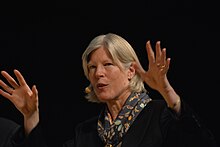Cynthia Kenyon
Cynthia Jane Kenyon (born February 21, 1954 in Chicago ) is an American molecular biologist who studies the genetics of the aging process ( gerontogens ).
biography
Kenyon grew up in Athens, Georgia , where her parents were employed at the University of Georgia , her father as a geography professor . Kenyon studied chemistry and biochemistry at the same university (bachelor's degree in 1976). She then did her doctorate in 1981 at the Massachusetts Institute of Technology under Graham C. Walker , where she demonstrated the activation of DNA repair genes after DNA damage in E. coli bacteria. As a post-doctoral student, she researched the gene regulation of the morphogenesis of the nematode C. elegans (with which she was already familiar in Robert Horvitz's laboratory at MIT) with Sydney Brenner at the MRC laboratory in Cambridge . There she discovered that genes ( Hox genes ) active in morphogenesis in Drosophila are also active in C. elegans . Since 1986 she has been Assistant Professor (from 1994 with full professorship) at the University of California, San Francisco (UCSF), where she has been the Herbert Boyer Distinguished Professor of Biochemistry and Biophysics since 1997 and American Cancer Society Professor since 2005 . She heads the UCSF's Hillblom Center for the Biology of Aging.
In 1993 she discovered in her laboratory that a single mutation in the daf-2 gene of C. elegans doubled the life span. Soon afterwards she discovered that a mutation in another gene (daf-16m) reversed this, meaning that other genes determine the life span of C. elegans . She also showed that both genes regulate activities of other genes and act against each other. When it was discovered that the daf-2 gene encodes a hormone receptor on the cell surface with hormones similar to insulin and insulin-like growth factor I in higher organisms, Kenyon investigated the effects of drugs to delay the aging process. To this end, she founded Elixir Pharmaceuticals in Boston in 1999 with Leonard Guarente .
In 2003 she showed that by weakening the daf-2 gene and destroying cells in the reproductive system, the life expectancy of C. elegans can be increased from 20 days to up to 125 days.
Since discovering that glucose consumption is shortening the life expectancy of C. elegans , she has been following a low glycemic index diet herself .
She is a member of the National Academy of Sciences (2003) and the American Academy of Arts and Sciences (1997). In 2000 she received the König Faisal Prize for Medicine. She also received the American Association of Medical Colleges Award for Distinguished Research , the Discover Prize for Basic Research in 2004 and the Ilse & Helmut Wachter Award for Exceptional Scientific Achievement in 2005 . In 2006 she received the Longevity Prize from the IPSEN Foundation. In 2003 she was President of the Genetics Society of America .
She is currently employed by Calico (a subsidiary of Google) as Vice President and Age Researcher.
literature
- Lisa Yount: A to Z of woman in science and math. (A Biographical Dictionary). Facts on File, New York NY 1999, ISBN 0-8160-3797-3 (Revised edition. Ibid 2008, ISBN 0-8160-6695-7 ).
Web links
Individual evidence
- ↑ Bill O'Neill: In Methuselah's Mold. In: PLoS Biology. 2, 2004, p. E12, doi : 10.1371 / journal.pbio.0020012 .
| personal data | |
|---|---|
| SURNAME | Kenyon, Cynthia |
| ALTERNATIVE NAMES | Kenyon, Cynthia Jane (full name) |
| BRIEF DESCRIPTION | American molecular biologist |
| DATE OF BIRTH | February 21, 1954 |
| PLACE OF BIRTH | Chicago |
